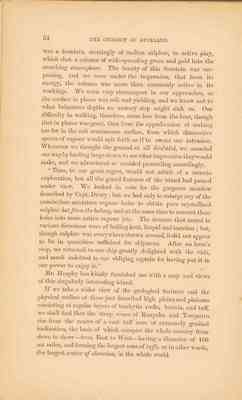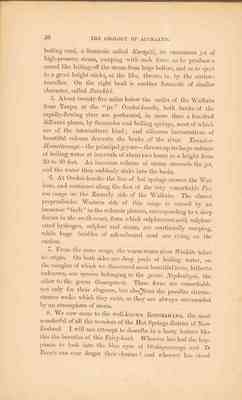Pages
32 THE GEOLOGY OF AUCKLAND.
stretches in a more northerly direction to the East Coast, between Maketu and Tauranga, the farthest extremities of which reach even to the Auckland District. On one side of Hauraki Gulf, the Coromandel range is covered with trachytic breccia, and again, on the West Coast, the same rock forms the coastrange from Manukau to Kaipara. This extensive plateau is intersected by many deep valleys, the sides of which are characterised by a succession of remarkable terraces. The same plateau is also broken in many places by more or less regular trachytic cones from 1000 to 3000 feet high. That you may become acquainted with the geological character of such mountains, I will mention several examples, the names of which are well known amongst European settlers. To this class of mountains belong Karioi on the West Coast, near Whaingaroa, Pirongia or the Waipa, the regular cone of Kakepuku between the Waipa and the Waikato, Maungatautari on the Waikato, Aroha on the Waihou, Putauaki or Mount Edgecombe on the East Coast, and many others. The only active mountain which belongs to this class is Whakari or White Island, in the Bay of Plenty, a solfatara like the active crater of Tongariro.
Mr David Burn, in his account of "A Trip to the East Cape," says:-
"In about an hour after passing Flat Island, the snowy vapour upon White Island began to be discernible. By 1 p.m. we were in immediate contiguity with this remarkable island, passing quite close to its southern extremity. As we made our gradual approach, its aspect was of the most singular description. Except on its northern point, to which the sulphurous vapour does not seem to reach, it is utterly destitute of vegetation; there are patches of growing underwood; but in every other direction, the island is bald, bleak, and furrowed into countless deep-worn ravines. After we had passed it a short distance to the eastward, the capacious basin of the crater, with its numerous geysers roaring and raging, exposed its sulphurous bosom to our eyes and nostrils. If the outer and western sides of White Island be blank and furrowed, its inner circle is chased, as it were, in a rare and picturesque manner - the sides of the hills, from their lofty mountain summits to the base, being
THE GEOLOGY OF AUCKLAND. 33
combed into innumerable longitudinal ridges of a florescent bronze of brilliant and variegated hue.
"Of this island, Captain Drury, of H.M.S. Pandora, gives the following description in the 'New Zealand Pilot':-
" 'White Island, or Whakari, is about three miles in circumference, and 860 feet high. The base of the crater is one and a half miles in circuit, and level with the sea. In the centre is a boiling spring about 100 yards in circumference, sending volumes of steam full two thousand feet high in calm weather. Around the edges of the crater are numberless smaller geysers sounding like so many high-pressure engines, and emitting steam with such velocity that a stone thrown into the vortex would immediately be shot in the air.
" 'Here and there are lakes of sulphurous water, dormant; but the whole island is so heated as to make it difficult to walk. From the edges of the crater to the scene below is only to be compared to a well-dressed meadow of gorgeous green, with meandering streams feeding the boiling cauldron; but on approaching, we find this green to be the purest crystallised sulphur.
" 'No animal or insect breathes on this island, scarcely a limpet on the stones, and 200 fathoms will hardly reach the bottom within half a mile of its shores.'
"Being under the lee of the island and in smooth water, Captain Bowden, in the most obliging manner, hove the steamer to, and lowering one of the quarter boats, conveyed us on shore to enjoy a personal inspection of this grand natural curiosity. There are two spots at which a landing may be effected, at the openings of the outer base of the crater; by a very little exertion in clearing away some of the boulders, the landing may be rendered perfectly easy; but although, this day, the water was smooth, still there was such a swell that judgment and caution were requisite to pick out a spot where best to escape the rollers that tumbled on the rough and broken beach.
"Never shall we forget the grand displays which we beheld in this sulphurous caldron. Its paintings fresh from Nature's hand - its lake of gorgeous green - its roaring jets of stormy vapour - are things to be witnessed, difficult to be described; but surprassing all these, and as if their central attraction, there
34 THE GEOLOGY OF AUCKLAND.
was a fountain, seemingly of molten sulphur, in active play, which shot a column of wide-spreading green and gold into the scorching atmosphere. The beauty of this fountain was surpassing, and we were under the impression, that from its energy, the volcano was more than commonly active in its workings. We were very circumspect in our approaches, as the surface in places was soft and yielding, and we knew not to what brimstone depths an unwary step might sink us. Our difficulty in walking, therefore, arose less from the heat, though that in places was great, than from the apprehension of sinking too far in the soft crustaceous surface, from which diminutive spouts of vapour would spit forth as if to resent our intrusion. Whenever we thought the ground at all doubtful, we sounded our way by hurling large stones to see what impression the would make, and we adventured or avoided proceeding accordingly.
"Time, to our great regret, would not admit of a minute exploration, but all the grand features of the island had passed under view. We looked in vain for the gorgeous meadow described by Capt. Drury; but we had only to enlarge any of the numberless miniature vapour holes to obtain pure crystallised sulphur hot from the bakery, and at the same time to convert these holes into more active vapour jets. The streams that issued in various directions were of boiling heat, limpid and tasteless; but, though sulphur was everywhere strewn around, it did not appear to be in quantities sufficient for shipment. After an hour's stop, we returned to our ship greatly delighted with the visit, and much indebted to our obliging captain for having put it in our power to enjoy it."
Mr Heaphy has kindly furnished me with a map and views of this singularly interesting island.
If we take a wider view of the geological features and the physical outline of these just described high plains and plateaus consisting of regular layers of trachytic rocks, breccia, and tuff, we shall find that the steep cones of Ruapahu and Tongariro rise from the centre of a vast tuff cone of extremely gradual inclination, the basis of which occupies the whole country from shore to shore - from East to West - having a diameter of 100 sea miles, and forming the largest cone of tuffs, or in other words, the largest crater of elevation, in the whole world.
THE GEOLOGY OF AUCKLAND. 35
The Hot Springs.
Intimately acquainted with the described volcanic phenomena of the active and extinct volcanic mountains, are the Solfataras, Fumaroles, and Hot Springs. They are found in a long series, stretcing across the country in a N.N.E. direction, from the active crater Ngauruhoe in the Tongariro system, to the active crater of White Island (Whakari). They occupy the chasms and fissures to which I have already referred.
There is only one other place in the world in which such a number of hot springs are found that have periodical outbursts of boiling water - that is, in Iceland, the well-known geysers of which are of precisely similar character to those in New Zealand. The geysers or boiling fountains of Iceland, long celebrated for possessing this property in an extraordinary degree, have, indeed, strong rivals in the puias and ngawhas of New Zealand. Although there may be no single intermittent spring in New Zealand of equal magnitude with the great geyser in Iceland, yet in the extent of country in which such springs occur, in the immense number of them, and in the beauty and extent of the siliceous incrustations and deposits, New Zealand far exceeds Iceland.
In enumerating the principal of this phenomena, we may begin with -
1. The active craters of Tongariro, which are at present in the condition of solfataras that may be called the state of repose of active craters, and with the hot springs rising on the slope and at the base of that mountain.
2. We then pass on to the Tokanu and Terapa springs on the Southern extremity of the Taupo lake. The principal "Puia" at Tokanu is called Pirori, an intermittent fountain whose column of boiling water, of two feet in diameter, sometimes reaches a height of more than 40 feet.
3. On the opposite side of Taupo, at the Northern extremity of the lake, we again meet with hot springs, and with a river of warm water called Waipahihi, which, rising in the extinct volcanic cone of Tauhara, falls, in a vapour-crowned cascade, into Taupo.
4. Descending from Taupo by the outlet of the Waikato, we find on the left bank, in the midst of a great number of pools of D
36. THE GEOLOGY OF AUCKLAND.
boiling mud, a fumarole called Karapiti, an enormous jet of high-pressure steam, escaping with such force as to produce a sound like letting-off the steam from huge boilers, and as to eject to a great height sticks, or the like, thrown in by the curious traveller. On the right bank is another fumarole of similar character, called Parakiri.
5. About twenty-five miles below the outlet of the Waikato from Taupo, at the "pa" Orakei-korako, both banks of the rapidly-flowing river are perforated, in more than a hundred different places, by fumaroles and boiling springs, most of which are of the intermittent kind; and siliceous incrustations of beautiful colours decorate the banks of the river. Temini-aHomaiterangi - the principal geyser - throws up its large column of boiling water at intervals of about two hours to a height from 20 to 30 feet. An immense volume of steam succeeds the jet, and the water then suddenly sinks into the basin.
6. At Orakei-korako the line of hot springs crosses the Waikato, and continues along the foot of the very remarkable Pairoa range on the Easterly side of the Waikato. The almost perpendicular Western side of this range is cause bdy an immense "fault" in the volcanic plateau, corresponding to a deep fissure in the earth-crust, from which sulphureous acid, sulphuretted hydrogen, sulphur and steam, are continually escaping, while huge bubbles of ash-coloured mud are rising on the surface.
7. From the same range, the warm-water river Waikite takes its origin. On both sides are deep pools of boiling water, on the margins of which we discovered most beautiful ferns, hitherto unknown, one species belonging to the genus Nephrolepis, the other to the genus Goneopteris. These ferns are remarkable not only for their elegance, but also from the peculiar circumstances under which they exist, as they are always surrounded by an atmosphere of steam.
8. We now come to the well-known ROTOMAHANA, the most wonderful of all the wonders of the Hot Springs district of New Zealand. I will not attempt to describe in a hasty lecture like this the beauties of this Fairy-land. Whoever has had this happiness to look into the blue eyes of Otukapuarangi and Te Tarata can ever forget their charms? and whoever has stood




